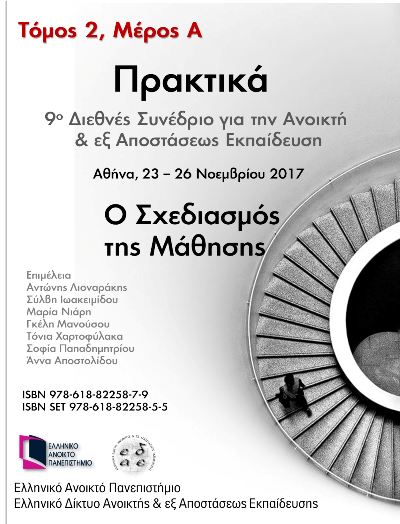Μετάβαση από το σχολείο στο πανεπιστήμιο: μέσα μάθησης και τρόποι αξιοποίησης της τεχνολογίας από νεοεισερχόμενους φοιτητές - υποψήφιους εκπαιδευτικούς

Δημοσιευμένα:
Δεκ 21, 2017
Λέξεις-κλειδιά:
Μέθοδοι Μάθησης Φοιτητών Δεξιότητες Ηλεκτρονικών Υπολογιστών Φοιτητών Δεξιότητες Διαδικτύου Φοιτητών
Περίληψη
Η παρούσα εργασία είναι αποτέλεσμα έρευνας τεσσάρων ακαδημαϊκών ετών, από το 2013 ως 2017, στο Παιδαγωγικό Τμήμα Δημοτικής Εκπαίδευσης (Π.Τ.Δ.Ε) του Πανεπιστημίου Πατρών. Η έρευνα απευθύνεται στους νεοεισερχόμενους φοιτητές του Τμήματος. Ο σκοπός της έρευνας είναι να διαπιστωθούν οι τρόποι μάθησης στο μεταβατικό στάδιο από το σχολείο στο πανεπιστήμιο και να αναζητηθούν οι τάσεις χρήσης στο διαδίκτυο και των μέσων κοινωνικής δικτύωσης για εκπαίδευση, πληροφόρηση και επικοινωνία.
Λεπτομέρειες άρθρου
- Ενότητα
- Άρθρα
Οι συγγραφείς των άρθρων που δημοσιεύονται στα πρακτικά του συνεδρίου για την Ανοικτή και εξ Αποστάσεως Εκπαίδευση διατηρούν τα δικαιώματα πνευματικής ιδιοκτησίας επί των άρθρων τους. Άρθρα που δημοσιεύονται στα πρακτικά διατίθενται με άδεια Creative Commons 4.0 και σύμφωνα με την άδεια μπορούν να χρησιμοποιούνται ελεύθερα, με αναφορά στο/στη συγγραφέα και στην πρώτη δημοσίευση για μη κερδοσκοπικούς σκοπούς και με δικαίωμα τροποποίησης μόνον με παρόμοια διανομή (αν αναμείξετε, τροποποιήσετε, ή δημιουργήσετε πάνω στο υλικό, πρέπει να διανείμετε τις δικές σας συνεισφορές υπό την ίδια άδεια όπως και το πρωτότυπο).
Αναφορές
Bryer J, & Speerschneider K. (2014) Likert functions to analyze and visualize Likert type items. R package version 1.1. Vienna, Austria: R Foundation for Statistical Computing, October 17, 2014. Available at: http://jason.bryer.org/likert.
Carmichael, E., Miller., K., & Smith, J. (2007). Researching literacy for learning in the vocational curriculum. In Osborne, M., Houston, M., & Toman, N. (Eds), The pedagogy of lifelong learning: Understanding effective teaching and learning in diverse contexts. London: Routledge.
Erdmann, N. (2014). The role of Internet in the learning culture among higher education students. In Proceedings of World Conference on Educational Multimedia, Hypermedia and Telecommunications 2014 (pp. 1990-1994). Chesapeake, VA: AACE.
Hanover Research (2015). 2016 Report: Trends in higher education marketing, enrollment, and technology. Arlington: Hanover Research.
Holt, D., Smissen, S., & Segrave, S. (2006). New students, new learning, new environments in higher education: Literacies in the digital age. In Proceedings of the 23rd Annual ASCILITE Conference “Who’s learning? Whose technology?” (pp. 327-336).
Κουστουράκης, Γ., & Παναγιωτακόπουλος, Χ. (2011). Διερεύνηση της εξοικείωσης των νεοεισερχόμενων φοιτητών με τις ΤΠΕ στο Τ.Ε.Ε.Α.Π.Η του Πανεπιστημίου Πατρών: μια διαχρονική μελέτη, 2ο Πανελλήνιο Συνέδριο – Πάτρας 28-30/4/2011.
Likert R (1932). A Technique for the Measurement of Attitudes. Archives of Psychology, 22(140), 1-55.
Littlejohn, A., Margaryan, A., & Vojt, G. (2010). Exploring Students’ use of ICT and Expectations of Learning Methods. Electronic Journal of e-Learning, 8(1), 13 – 20.
Owyang, J. (2009). A Collection of Social Network Stats for 2009. Retrieved from http://www.web-strategist.com/blog/2009/01/11/a-collection-of-soical-network-stats-for-2009/
Tsai, C.-C. (2009). Conceptions of learning versus conceptions of web-based learning: The differences revealed by college students. Computers & Education, 53(2009), 1092-1103.
Tsai, P.-S., Tsai, C.-C., & Hwang, G.-H. (2011). College students’ conceptions of context-aware ubiquitous learning: A phenomenographic analysis. Internet and Higher Education, 14(2011), 137-141.
Yang, F.-Y., Tsai, C.-C. (2009). Examining high-school students’ preferences toward learning environments, personal beliefs and concept learning in web-based contexts. Computers & Education, 52(2009), 848-857.


